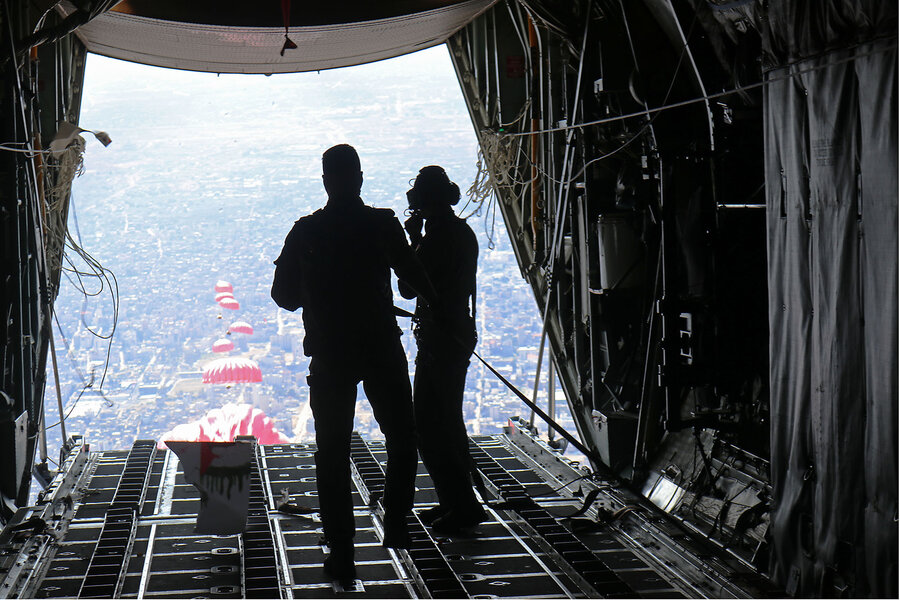My flight over Gaza in a plane dropping food aid
Loading...
| 3,000 feet above Gaza Strip
Thousands of pounds of flour, rice, sugar, ready-to-eat chicken, and Monitor correspondent Taylor Luck flew over Gaza on Friday.
He was the least important cargo, and he stayed aboard the Royal Jordanian Air Force plane carrying him. Everything else ended up on the ground. As a journalist, the closest he could get to Gaza was flying over the rubble and ash.
Why We Wrote This
Gaza has become too dangerous for humanitarian aid trucks, so parachuted supplies are all that Palestinians in Gaza can rely on. That aid is a drop in an ocean of need, and sometimes even it fails.
United Nations aid trucks are finding it increasingly difficult and dangerous to navigate Israeli military checkpoints and mobs of looters in Gaza.
So the nine cargo planes taking part in Friday’s daily airdrop were carrying the bulk of the aid that would reach 2.2 million Palestinians in the Gaza Strip.
Taylor watched as the planes were loaded with enough supplies to feed just 45,000 people, when over half a million Palestinians in Gaza are facing starvation, according to the U.N. Altogether, the fleet carried less than one truck could have managed.
Taylor’s plane dropped its load successfully. But tragically, he discovered later, one parachute from another plane failed to open: The falling pallet of humanitarian supplies killed at least five of the hundreds of people who were racing to the site of the airdrop so as to ensure they got their hands on something to eat.
Not the first time, Taylor reflected, the Gaza Strip had proved resistant to good news.
Thousands of pounds of flour, rice, sugar, ready-to-eat chicken, and I flew over Gaza on Friday.
I was the least important cargo, and I stayed aboard the Royal Jordanian Air Force plane. Everything else ended up on the ground. As a journalist, the closest I could get to the war zone was flying over the rubble and ash.
It will be weeks before the floating offshore pier that U.S. President Joe Biden announced Thursday will be ready to handle aid to Gaza. United Nations trucks, meanwhile, are finding it increasingly difficult and dangerous to navigate Israeli military checkpoints and mobs of looters.
Why We Wrote This
Gaza has become too dangerous for humanitarian aid trucks, so parachuted supplies are all that Palestinians in Gaza can rely on. That aid is a drop in an ocean of need, and sometimes even it fails.
So the nine cargo planes taking part in Friday’s daily airdrop were carrying the bulk of the aid that would reach 2.2 million Palestinians in the Gaza Strip.
This is thanks to Jordan, a tiny, resource-poor kingdom with barely any water, but lots of heart.
A humanitarian provider for Palestinian refugees since 1948, Jordan has been a logistics hub for humanitarian efforts since the Israel-Hamas war erupted. The Jordanian air force began airdrops into northern Gaza two weeks ago – with one of the first flights overseen by King Abdullah himself.
Jordan has since flown 34 aid drops, an operation that has recently been bolstered by aircraft from a burgeoning coalition, including Britain, France, the Netherlands, and the United States.
Nine aircraft, less aid than one truck
To witness a Jordanian drop over Gaza, I drove out early this morning to a remote military airfield east of Amman, where sheep outnumber people.
Parked on the tarmac, awaiting final Israeli flight clearance was the fleet providing today’s aid: four Jordanian cargo planes and a handful of foreign aircraft, including just one U.S. Air Force C-130.
I watched as the planes were loaded with crates of rice, sugar, powdered milk, and packages of ready-to-eat meals of rice and chicken. That was enough to feed just 45,000 people, when over half a million Palestinians in Gaza are facing starvation, according to the U.N. Altogether, the fleet carried less than one truck could have managed.
As a lifeline, it is a fraying thread.
But the cargo of these nine C-130s, if landed and distributed properly, could be the difference between life and death for thousands, at least for a few days.
“It is a huge feeling of responsibility,” Jordanian airman Mohammed Gharaibeh told me as he helped load a pallet onto a Jordanian C-130. “Cutting that rope and watching the packages drop, it feels good to know that you are helping. We are able to do something to ease the suffering.”
Jordan’s air force has been involved in dozens of humanitarian operations in the Middle East and North Africa – most recently in Sudan and earthquake-struck Turkey – but never before has it been limited to simply parachuting in aid and then returning to base.
That is now these Jordanian airmen’s daily routine.
Thirty minutes after takeoff, as we flew over the sea, loadmaster Saif Zahrawi tapped my shoulder, pointed out of the window, and said, “This is Gaza.”
I saw a Mediterranean coastline that, from a distance, appeared normal. As we got closer and descended to 3,000 feet, however, rubble-strewn plots and crumbling buildings came into view.
My thoughts immediately went to my colleague Ghada Abdulfattah in central Gaza, with whom I am in daily contact. The stretching landscape of charred houses and missile craters gave me new insight into the life-or-death obstacles she faces as she goes about her work. And I was a half-mile above her head.
I remembered her lack of water, heat, and food, her mother’s hunt for medicine. My heart was heavy; I wished, impossibly, that I could have brought everything in my kitchen and dropped it out of the plane to her. I felt futile at 3,000 feet.
Hope marred by tragedy
As we flew north, the crumbling buildings beneath us gave way to gray and blackened earth, as if a permanent shadow had been cast over Gaza City.
Suddenly, it was drop time. Three airmen opened the rear cargo door of the plane, and the two rows of eight parachute-packed cartons slid out neatly, one after the other. Within a few seconds, the drop was done.
The loadmaster at the very rear of the plane, nearly dangling out the door, raised a thumbs-up in the air. A successful drop. Our plane circled Gaza City to watch the parachutes’ trajectory.
And that was it. There was no clapping nor cheers, no high-fives. Just a simple thumbs-up and silence to mark another day’s work.
Tragically, as I discovered when I returned home to Amman, Friday’s operation carried a heavy cost. One of the parachutes – it is unclear from which plane – failed to open: The falling pallet of humanitarian supplies killed at least two of the hundreds of people who were racing to the site of the airdrop so as to ensure they got their hands on something to eat. Reports later indicated that the number rose to five.
Not the first time, I reflected, the Gaza Strip had proved resistant to good news.










